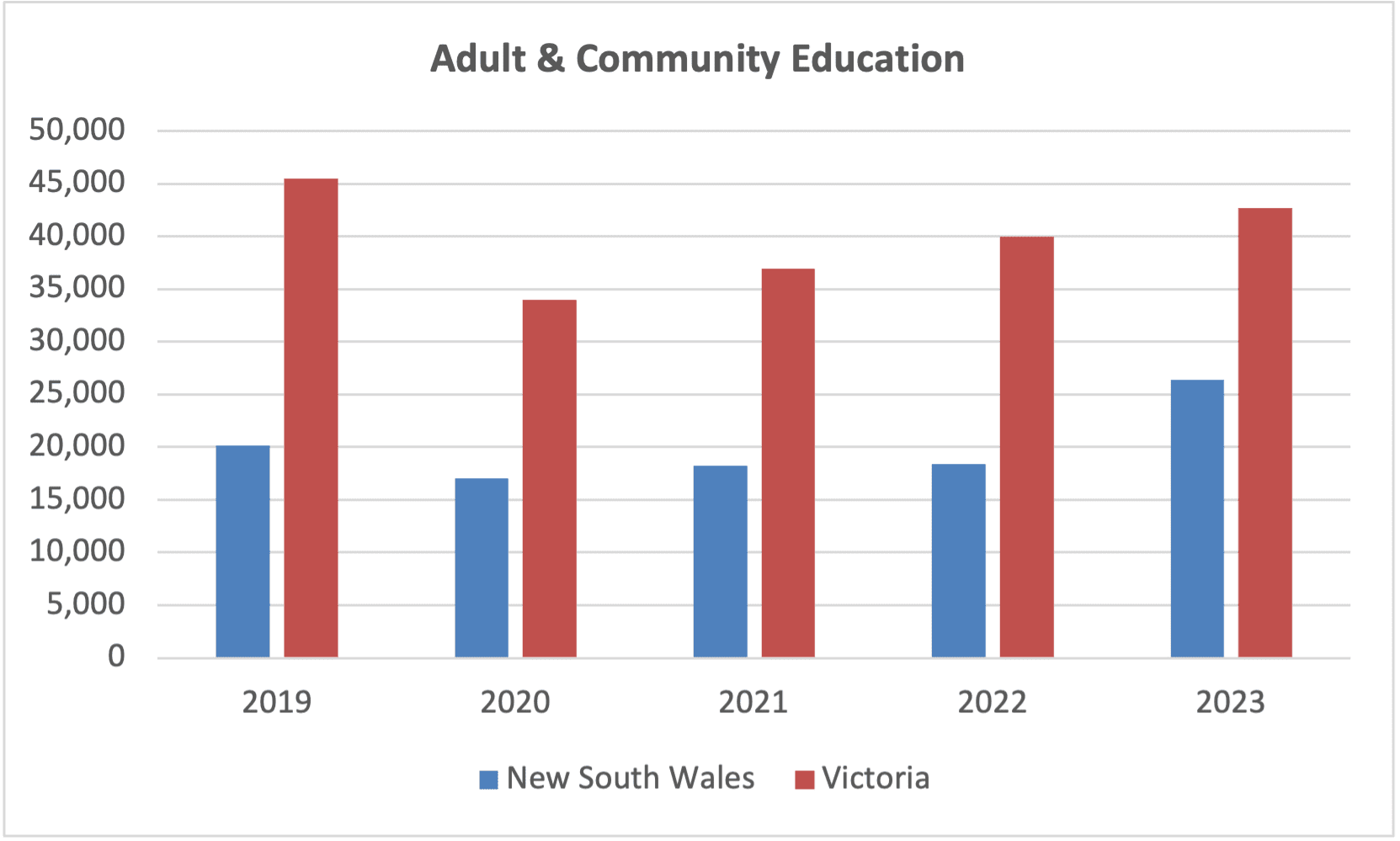
Government-funded VET activity in 2023 – where did students study and what were they learning?
Despite the focus on Fee-Free TAFE for both the Australian and State/Territory governments – the latest NCVER data shows that there was still a surprising number of government-funded students enrolled with private and community education providers in 2023.
Firstly the 2023 government-funded VET data shows that the numbers of government-funded students in 2023 across the different jurisdictions was comparable with student numbers in 2021 and a modest increase on 2022 (except in the ACT where government-funded VET students declined by 10% between 2022 and 2023).

When looked at across different jurisdictions, there was no clear pattern of growth in government-funded VET students studying at TAFE Institutes and other government providers in the last five years.
In New South Wales – student numbers grew in the last 12 months but were down on 2020 figures (this is partly explained by the NSW government’s emphasis on funding some non-nationally recognised training with their government funding and student numbers in this category increased sharply during the pandemic as they and the NSW government sought short courses to fill immediate skills gaps).
In Victoria enrolments were stable between 2022 and 2023, but were down on 2019 and 2021 government-funded student enrolments numbers.
Queensland has seen sustained growth in government-funded students at TAFE Queensland, but with a higher proportion of government-funded students studying with private providers than in other jurisdictions.
Between 2022 and 2023 government-funded students increased in TAFE SA and the Western Australia TAFE Institutes.
And in the smaller jurisdictions – numbers were largely stable over the five year period although, as noted above, declined in the ACT in the last 12 months.

By contrast the picture for private training providers showed government-funded students:
- declined in NSW in the last 12 months (after growth during the pandemic, and a subsequent change of government)
- have been growing in Victoria and Western Australia
- have declining in the last two years in Queensland
- had been growing in South Australia but following the change of government plateaued between 2022 and 2023
- grew and then declined in Tasmania and the ACT and,
- were stable in the Northern Territory.

The adult and community education sector is more difficult to analyse at a national level because it is not separately identified in many jurisdictions. In the two largest jurisdictions, New South Wales and Victoria, which both have an identifiable ACE sector:
- the ACE sector is stronger in Victoria than in NSW
- government-funded student numbers declined in Victoria between 2019 and 2020 but have subsequently been growing (albeit they are lower now than in 2019), and
- a similar pattern was also true in NSW but government-funded ACE students in 2023 were higher than in 2019.

While a large share of fee-for-service enrolments in private providers are in short courses, most government-funded activity is in full qualifications (although NSW has been an outlier in providing some of its government funding for skillsets). Here are the national-level government-funded enrolments by program type and it is clear that since the COVID-19 pandemic, governments have focussed their funding on Training Package enrolments:

At the State and Territory level – the distinction between government-funded enrolments (by provider type) in nationally recognised training and non-nationally recognised training:
- Queensland and the two territories (NT and the ACT) use government-funding only for nationally recognised training
- Western Australia and Tasmania allocate some government-funding to non-nationally accredited training – delivered almost exclusively by TAFE Institutes (and other government providers)
- NSW, Victoria and South Australia use government-funding to fund some students in non-nationally recognised training – with NSW allocating that funding relatively equitably across TAFE and other government providers, ACE providers and private providers. Victoria allocates most funding for non-nationally recognised training to the ACE sector (its Learn Local providers) and South Australia gives most of its funding for non-nationally recognised training to TAFE SA.

When government-funded enrolments are analysed by Training Package – the dominance of the Community Services package is evident.
The significance of enrolments in non-Training Package programs is also more significant than when they are compared with aggregate Training Package enrolments.
Aside from the Community Services Training Package (258,410 enrolments) – the other Training Packages in the Top 10 for government-funded enrolments in 2023 were:
- Business Services 120,760
- Construction, Plumbing & Services Integrated Framework 120,285
- Health 69,930
- Tourism, Travel and Hospitality 67,430
- Electrotechnology 66,210
- Automotive Industry Retail, Service and Repair 51,540
- Metal and Engineering 44,115
- Agriculture, Horticulture and Conservation and Land Management 38,630
- ICT 31,280
Looked at by provider type, the importance of community education and private providers in delivering government-funded community services training is apparent. And private providers also play an important role in the delivery of government-funded training in the travel, tourism and hospitality sectors.
Understanding more about the profile of ‘other’ training providers delivering government-funded training in the agriculture, automotive, construction and plumbing, and tourism, travel and hospitality sectors would be a useful addition to the data collection given the relative importance of their contribution.




